Making connections to ensure a clean and healthy Chesapeake Bay
Suzanne Webster ·On October 29, I attended a one-day conference called "Ensure a clean & healthy Chesapeake Bay," which was held at the University of Maryland College Park Campus and hosted by the College of Agriculture & Natural Resources (AGNR). This conference was the second annual AGNR cornerstone event for one of the college's five strategic initiatives (the namesake of the conference), and was an opportunity to showcase some of the ongoing Bay-related research at the University of Maryland, especially through AGNR and the Maryland Extension program. Dean Craig Beyrouty provided a brief welcome to attendees and then we jumped right into the morning plenary session.
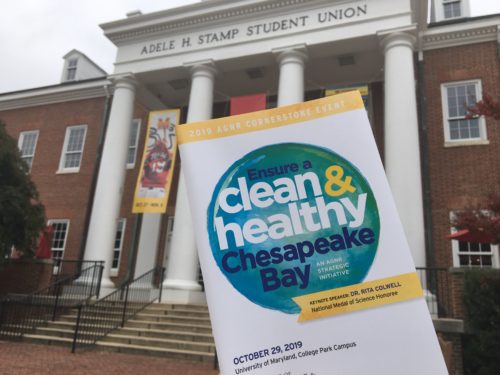
Lee Currey, Director of the
Water & Science Administration at the Maryland
Department of the Environment, spoke about the history of restoration
in the Chesapeake Bay. His talk was particularly interesting to me because I am
studying this timeline and trajectory as part of my dissertation research on
public engagement in Chesapeake Bay science and management. During his presentation,
Currey highlighted several major restoration initiatives in the Chesapeake Bay
watershed, including pollution reduction and wastewater treatment, and
described some of the drivers, long-term restoration strategies, and
anticipated challenges for each. To continue our long history of success and leadership
in Bay management, he emphasized the importance of timely and transparent
science (and gave a shout-out to UMCES for our Chesapeake Bay Report Card!), implementing short
and long-term management strategies, and linking economic value with
co-benefits to communities and public health.
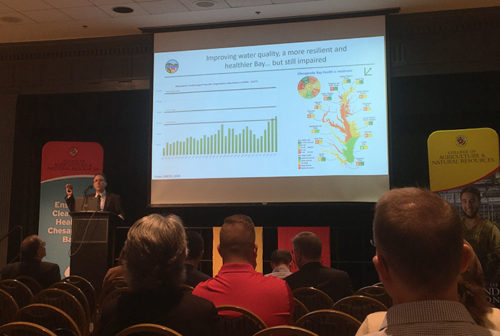
Next on the agenda were concurrent
morning sessions on a wide variety of topics, including land use management, best
practices in governance of water, and sustainable management of agricultural
nutrients. I chose to attend a two-part session focused on creating environmentally
aware communities, moderated by Jen Dindinger, a Watershed Restoration
Specialist at Maryland
Sea Grant Extension. Speakers highlighted several train-the-trainer
programs that aim to provide science-based education, create behavior change,
and help people adopt stewardship practices that improve Bay health. Some of
the programs that were highlighted were the Watershed
Stewards Academy, the Bay-Wise
Landscape Management Program, and the Chesapeake
Bay Landscape Professional Certification. Across the board, speakers emphasized
the importance of collaboration and listening, facilitating connections between
experts, and taking care to not duplicate efforts in order to affect change.
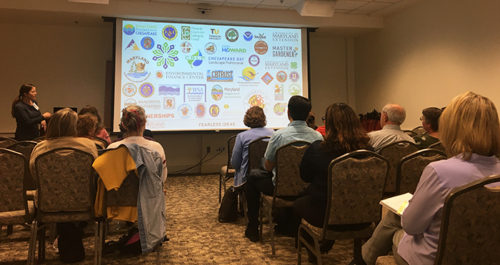
The morning sessions were
followed by a combination lunch and poster session. I ended up sitting next to
several Maryland Extension specialists during lunch, and it was fascinating to
hear about the diversity of their work. I learned about this conference after
the poster abstract submission deadline had already passed, so instead of
presenting my own research, I thought it might be fun to serve as a poster judge.
Looking around the room, I was really impressed with the huge variety in
research efforts related to the Chesapeake Bay, and it was fun to see IAN symbols scattered around the
room. One thing that I am especially motivated to work on for my own
presentations in the future is being very clear from the very beginning about
both the main objectives of my work, as well as the overall broader impacts. I
listened to several wonderfully informative and professional presentations, but
I found myself wondering at the end of many of them what the research would
ultimately be used for and who would benefit from it.
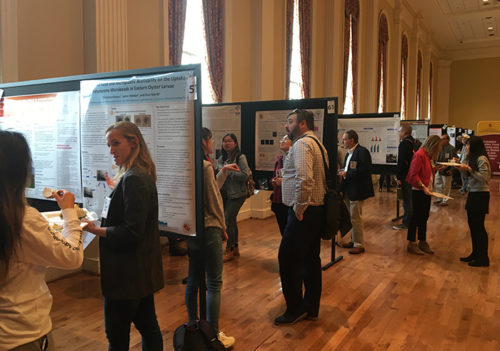
The subsequent keynote
presentation was given by Dr. Rita Colwell, a Distinguished University
Professor and forly Director of the National Science Foundation. She spoke
about her research on a type of bacteria called Vibrio.
Dr. Colwell has found that across the globe, from the Chesapeake Bay to
Bangladesh and Haiti, the spread of Vibrio
is strongly linked to environmental and climate variables, such as water
temperature and rainfall. During her presentation, she used a graphic that I
thought was particularly effective— an animation of a spinning earth with the
countries color-coded to depict the prevalence of cholera. She also emphasized
the connection between public health and environmental
condition, and provided many examples of collaborative and
interdisciplinary research efforts that are tackling this particular issue.

The last presentation of the day was a panel discussion on the "Integrated role of research, extension, and teaching in restoring the Chesapeake Bay." Panelists represented various environmental organizations that would be considered leaders and stakeholders in the conversation surrounding Chesapeake Bay management. The speakers were Alison Prost (Chesapeake Bay Foundation), John Torres (Maryland Farm Bureau), MEES alumna Suzanne Dorsey (Maryland Department of the Environment), David Goshorn (Maryland Department of Natural Resources), Ann Swanson (Chesapeake Bay Commission) and Hans Schmidt (Maryland Department of Agriculture). One highlight of the discussion was when panelists took turns explaining what exactly they mean when they talk about "restoring the Bay." Combined, panelists envision restoration as the process of coming to understand both the ecology of the Bay, including its human stakeholders, and the relationship between the natural and built environments, and then continuously using new science to set goals reflecting desired ecological conditions and inform decisions that eventually result in a self-sustaining natural system. Regardless of the exact definition or goals for restoration, Torres stressed that the key to making progress will be to "communicate, collaborate, and cooperate."
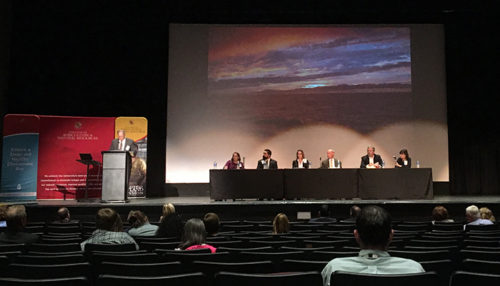
In fact, for me, these three tenets seemed to stand out as
major take-home messages from the conference, as a whole:
1. Communicate
It is crucial that we effectively communicate science to the public and to decision makers. Ann Swanson even suggested that UMD create a certificate program that would provide scholars with specialized training in how to provide technical assistance, and predicted that, increasingly, "the skill set of reaching out and translating science to the public will deeply matter."
2. Collaborate
Many presenters placed an emphasis on the value of partnerships, encouraging their audiences to build cross-disciplinary collaborations and connect with people who have different areas of expertise. Alison Prost took this a step further and highlighted the value of integration and interdisciplinary translation by encouraging students to take classes in different departments because "we all bring expertise to the table but we have to be able to understand how it's all related".
3. Cooperate
We need to not just work together, but to work well together. Similarly, we must work with stakeholders who might not be the easiest or most obvious match, but whose input is important if we are going to manage the Bay as a complex socio-ecological system. Ann Swanson stated that the Chesapeake Bay is unique in that we have a "mix of thoughtful leaders who are thoughtful enough to work with each other" despite their different perspectives and priorities. She suggested that our current system of managing the Bay works relatively well because instead of having one dominant individual or organization that is "always calling the shots," we have many clear leaders who are not only able to step up to the challenge when it is the right moment for them to lead, but who are also willing to take a supporting role at other times when another partner might be better suited for the leadership position.
All in all, the conference was very thought-provoking and I
am thankful for the opportunity to have attended.
About the author
Suzanne Webster
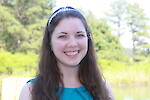
Suzi Webster is a PhD Candidate at UMCES. Suzi's dissertation research investigates stakeholder perspectives on how citizen science can contribute to scientific research that informs collaborative and innovative environmental management decisions. Her work provides evidence-based recommendations for expanded public engagement in environmental science and management in the Chesapeake Bay and beyond. Suzi is currently a Knauss Marine Policy Fellow, and she works in NOAA’s Technology Partnerships Office as their first Stakeholder Engagement and Communications Specialist.
Previously, Suzi worked as a Graduate Assistant at IAN for six years. During her time at IAN, she contributed to various communications products, led an effort to create a citizen science monitoring program, and assisted in developing and teaching a variety of graduate- and professional-level courses relating to environmental management, science communication, and interdisciplinary environmental research. Before joining IAN, Suzi worked as a research assistant at the Marine Biological Laboratory in Woods Hole, MA and received a B.S. in Biology and Anthropology from the University of Notre Dame.

